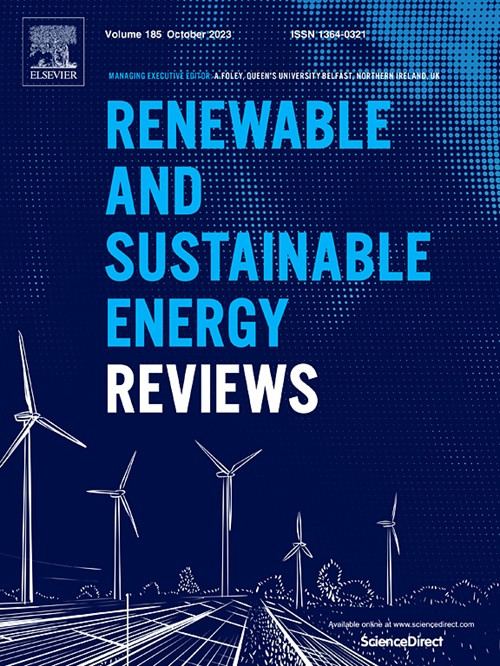Dynamic life cycle assessment of building stocks: a systematic review
IF 16.3
1区 工程技术
Q1 ENERGY & FUELS
引用次数: 0
Abstract
The considerable environmental impact of the building sector on resource use and emissions drives the need for comprehensive environmental impact assessments to support sustainability efforts. As buildings become operationally more efficient, the environmental impacts of construction materials become more important. Incorporating spatiotemporal dynamics into building stock modelling can enhance assessment accuracy, informing policymakers on strategies to mitigate environmental impacts.
This systematic review analyses recent scientific literature on environmental modelling, focusing on life cycle assessment and material flow analysis studies of building stocks, their impact assessments, and associated spatiotemporal dynamics. The review identified 27 relevant studies, from which information was extracted on various aspects such as study goals, scope, methodologies, and impact categories. The selected studies were also analysed for spatiotemporal dynamics inclusion, identifying 17 dynamic parameters further grouped into five categories. The dynamic parameters were investigated for the methods and data sources used to predict their temporal evolution or spatial distribution.
The results revealed a shift towards large-scale and data-driven modelling, assessing macro-level changes in the building stock. The study identified several limitations related to building stock modelling practices, such as the need for clearly defined modelling methods, consideration of various impact categories, and uncertainty analysis. The findings on dynamic parameters identified common approaches when modelling building stock changes, potentially aiding in establishing standardised methods for dynamic building stock modelling, thus improving consistency and comparability between studies. Further research is needed to investigate the impact of chosen approaches on results and examine the interconnected nature of these parameters.

建筑存量动态生命周期评价:系统综述
建筑行业对资源使用和排放的巨大环境影响促使需要进行全面的环境影响评估,以支持可持续发展的努力。随着建筑的运行效率越来越高,建筑材料对环境的影响变得越来越重要。将时空动态纳入建筑存量模型可以提高评估的准确性,为决策者提供减轻环境影响的策略信息。本文系统地分析了最近关于环境建模的科学文献,重点关注建筑存量的生命周期评估和物质流分析研究、影响评估以及相关的时空动态。本综述确定了27项相关研究,从中提取了研究目标、范围、方法和影响类别等各方面的信息。本文还分析了所选研究的时空动态包容性,确定了17个动态参数,进一步分为5类。研究了用于预测其时间演变或空间分布的方法和数据源的动态参数。结果揭示了向大规模和数据驱动模型的转变,评估建筑存量的宏观层面变化。该研究确定了与建筑存量建模实践有关的几个限制,例如需要明确定义的建模方法、考虑各种影响类别和不确定性分析。关于动态参数的研究结果确定了模拟建筑存量变化的常用方法,可能有助于建立动态建筑存量建模的标准化方法,从而提高研究之间的一致性和可比性。需要进一步的研究来调查所选择的方法对结果的影响,并检查这些参数的相互联系的性质。
本文章由计算机程序翻译,如有差异,请以英文原文为准。
求助全文
约1分钟内获得全文
求助全文
来源期刊

Renewable and Sustainable Energy Reviews
工程技术-能源与燃料
CiteScore
31.20
自引率
5.70%
发文量
1055
审稿时长
62 days
期刊介绍:
The mission of Renewable and Sustainable Energy Reviews is to disseminate the most compelling and pertinent critical insights in renewable and sustainable energy, fostering collaboration among the research community, private sector, and policy and decision makers. The journal aims to exchange challenges, solutions, innovative concepts, and technologies, contributing to sustainable development, the transition to a low-carbon future, and the attainment of emissions targets outlined by the United Nations Framework Convention on Climate Change.
Renewable and Sustainable Energy Reviews publishes a diverse range of content, including review papers, original research, case studies, and analyses of new technologies, all featuring a substantial review component such as critique, comparison, or analysis. Introducing a distinctive paper type, Expert Insights, the journal presents commissioned mini-reviews authored by field leaders, addressing topics of significant interest. Case studies undergo consideration only if they showcase the work's applicability to other regions or contribute valuable insights to the broader field of renewable and sustainable energy. Notably, a bibliographic or literature review lacking critical analysis is deemed unsuitable for publication.
 求助内容:
求助内容: 应助结果提醒方式:
应助结果提醒方式:


